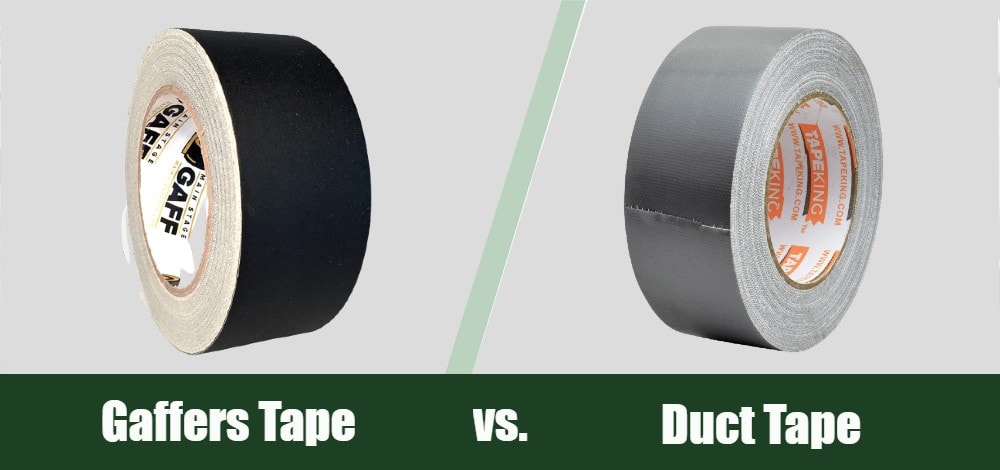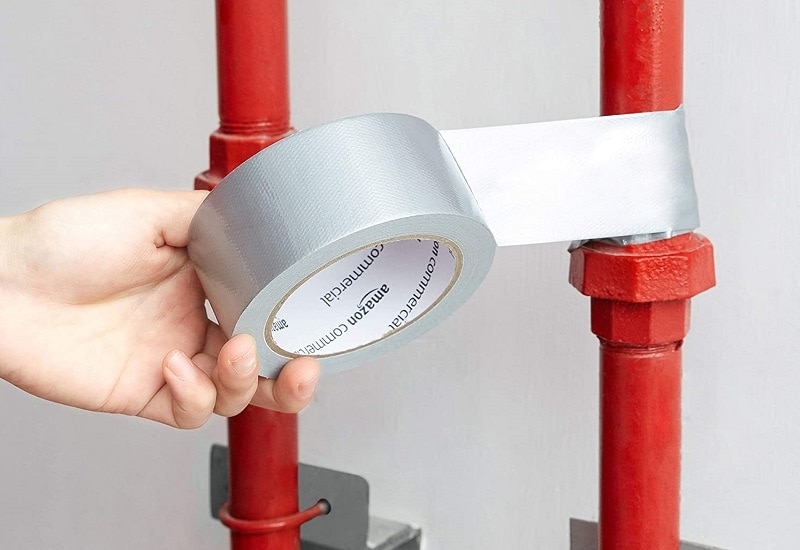Gaffers Tape vs Duct Tape: What’s the Difference?
-
- Last updated:

If you have ever been comparing tape types, you probably notice that gaffers tape is more expensive than duct tape, even though they look really similar. Why is that? More so, gaffers tape is preferred in certain settings over duct tape. Once again, why would there be any difference between these two multipurpose tapes?
The answer to those questions is pretty simple: the tapes are made from different materials, meaning that they have different properties. In this article, we dig into their differences in more detail. We begin by looking at each type individually, and then we help you decide which tape you should get for your needs. Let’s get started.

Overview of Gaffers Tape:

Though “gaffers tape” is the most commonly used name, you can find this tape type under several other names too. You may see it referred to as gaffer tape, gaff tape, or spike tape. Most often, gaffers tape is used in photography, theater, movie and television production, and industrial stage work. That’s because the tape easily camouflages into the background, holds items in place, and does not damage the ground.
Material
What makes gaffers tape different from duct tape is the material it is made from. Unlike duct tape, gaffers tape is made from fabric instead of vinyl or plastic. Though this may not sound like a huge difference, it affects how the tape looks, reacts to heat, and affects the surface it is taped to.
Top
One of the best benefits of a fabric material is that the top is non-reflective. In other words, it does not reflect light. Instead, gaffers tape is often matte black, allowing it to blend into the surface. This is incredibly helpful in theater and photography since the illusion is not destroyed by reflective tape.
Adhesive
In addition to the non-reflective surface, the fabric material makes the adhesive strong yet nondamaging. The fabric is more resistant to heat, which prevents the tape from leaving a sticky residue whenever it is removed. This fact protects the surface below, making it ideal for temporary or sensitive structures.
Best For
Because of the non-reflective and residue-free removal, gaffers tape is often used in theaters, the arts, and other settings where the tape needs to both be inconspicuous and nondamaging. These features also make it ideal for temporary uses since it can easily be removed.
- Non-reflective
- Does not leave sticky residue
- Heat resistant
- Expensive

Overview of Duct Tape:

Duct tape is a great item to keep in your home. It can easily hold things together, such as a broken toy or surface. By selecting different colored duct tape, you can even color code items or decorate your personal belongings, such as notebooks or pens.
Unlike gaffers tape, duct tape is the better option for permanent fixtures. Because od the material it is made from, it leaves a sticky residue and can potentially damage the surface. Still, the tape is waterproof and highly affordable, making it a great multipurpose option.
Material
Duct tape is made from vinyl or plastic. It will have a polyethylene resin on one side and a rubber base adhesive on the other. Within the two sides, there is a fabric backing, giving the duct tape much more strength and versatility than regular tape.
Top
As we’ve already mentioned, duct tape has a reflective top. This reflective top is not bad in all situations. For example, it may be helpful to have a reflective surface if it needs to be spotted in the night time or if you need to easily find it at a later point. It also makes color coding or labeling items much easier. It can be a distraction, however, if you want to hide the tape from sight.
Adhesive
The biggest downside of duct tape is that the adhesive side is incredibly sticky and leaves a sticky residue whenever you remove the tape. This can damage the surface you’re taping and leave an ugly eyesore. To remove the residue, you will have to use a special cleaner, though it may not work completely.
Best For
Because of its versatile, strong, and affordability, duct tape is great for permanent home use. This is a great option for sealing or waterproofing duct work and joints. Not to mention, the traditionally gray color allows the tape to blend in with those items. So long as you don’t need to remove the tape, this is a great choice.
- Affordable
- Versatile
- Easy to find
- Leaves a sticky residue

Which Is Best?

Unfortunately, neither tape is necessarily better than the other. Instead, gaffers tape is better for certain situations, while duct tape is better for others. This means that the performance of the tape will largely depend on the job.
Gaffers tape is best for the arts, entertainment, and anything else that may require you to remove the tape after use. In contrast, duct tape is best whenever you need to permanently repair or fix some sort of structure.

Gaffers vs. Duct Tape: Which Is Right for You?
Situation
Tape to Choose
Permanent need
Duct tape
Temporary need
Gaffers tape
Can damage surface
Duct tape
Cannot damage surface
Gaffers tape
Waterproof
Duct tape
Resistant to heat
Gaffers tape
Highly flexible
Duct tape
Color coding, easy to spot, etc.
Duct tape
Blends into the surface, non-distracting
Gaffers tape
Affordable
Duct tape
If you are unclear of which tape to get, we have created these questions to help you figure it out. Ask yourself these questions to determine which tape you should buy:
Do I need permanent or temporary tape?
Most importantly, ask if you need a permanent or temporary tape. If you need a permanent tape, then opt for duct tape. It will be difficult to remove and will withstand a lot. For a temporary choice, go with gaffers tape.
Can I damage the surface below?
The last thing you want is to accidentally damage a surface that needs to look pristine or pretty. If you need to keep the surface as is, use gaffers tape. The adhesive side will easily remove so as not to damage the surface. If damaging the surface doesn’t matter to you, duct tape will work just fine.
Does the tape need to be resistant to heat or water?
The next question you ask yourself is whether or not the tape needs to be resistant to heat or water. On one hand, duct tape is incredibly resistant to water. This makes it a great choice for fixing plumbing or pipes. Unfortunately, duct tape is not heat resistant.
If you need a tape that is resistant to both heat and water, then gaffers tape is the best for you. It will be able to create a barrier from most moisture and will withstand a lot of heat. With that being said, the adhesive on gaffers tape is not waterproof. This means that gaffers tape isn’t the best option for fixing a leak.
How flexible does the tape need to be?
Next, how flexible does the tape need to be? Will the tape need to fit into tight areas or contour to irregular shapes? Or is a tight fit not very critical? If flexibility matters to you, then you should get duct tape. It is much easier to stretch duct tape and create a tight fit, even on odd structures. Gaffers tape, in contrast, is less flexible. It will hold its shape, but it may not be a tight fit.
Do I need a matte or reflective finish?
Depending on your project, the finish may matter a lot. Duct tape will come in multiple colors with a reflective finish. This is great for color coding or labeling your items. The reflective surface can be distracting or an eyesore on certain items, though.
Gaffers tape is almost always matte black, but you can find gaffers tape that has colors. This sort of tape will never be reflective. The non-reflective surface makes it ideal for when you want the tape to be invisible or hidden.
What is my budget like?
If you are on a tight budget, then you might need to get duct tape instead of gaffers tape. Duct tape costs about $7.99 for 60 yards. In contrast, gaffers tape cost about $19.99 for the same amount.

Conclusion
Though duct tape and gaffers tape are both multi purpose, they are not the same. Gaffers tape is rooted in fabric, allowing it to be non-reflective and easier to remove. Duct tape, in contrast, is often made of vinyl and plastic, creating a reflective and sticky surface. Though different, both tapes are incredibly useful and powerful adhesive machines!
Contents

